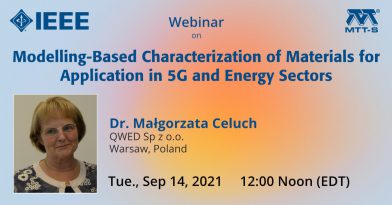
-
Tuesday, September 14, 2021 12:00 pm - 1:00 pm(New York Time) Add to my calendar
Modelling-Based Characterisation of Materials for Application in 5G and Energy Sectors
Dr. Małgorzata Celuch
QWED Sp z o.o., Warsaw, Poland
Abstract: The talk explores synergies between four pillars: the science of electromagnetic (EM) modelling, computer multiphysics simulations of EM wave interactions with materials, modelling-based design of applicators for materials processing and characterisation, the joint application of computer modelling and material measurements in emerging technologies and green energy sectors.
QuickWave conformal FDTD simulator software assists, on the one hand, in the design of energy-efficient microwave applicators for high-quality heating and microwavable food packages, and on the other hand, in the development of high-precision methods and test-fixtures for the characterisation of dielectric and conductive materials. Examples highlighted in the talk include:
- Electromagnetic simulations and design of antennas, for space research and for 5G (with new functionalities dedicated to steerable antenna arrays and multi-beam multi-band antenna systems, taking into account variable material parameters).
- Multiphysics simulations of domestic ovens loaded with foods, demonstrating the relationships between the FDTD and FEM methods and their different implementations, with real-life examples courtesy of Whirlpool Corporation and BSH Haugerate GmbH.
- Modelling-based measurement techniques for 5G materials, with round-robin testing of commercially available techniques in the iNEMI 5G initiative.
- Modelling-based imaging techniques for organic semiconductors and graphene anodes, developed by QWED in the European H2020-Framework MMAMA and NanoBat consortia.
We conclude with an outlook to new developments in materials modelling and characterisation, conducted within the H2020 NanoBat project and the European Materials Modelling (EMMC) and Characterisation (EMCC) Councils.
Speaker’s Bio: Dr. Malgorzata Celuch is QWED co-founder (1997), President (2017), and Senior Scientist, in addition to lead co-author of QuickWave multiphysics software package. Her modelling research dates back to M.Sc. (1988, honours) and Ph.D. (1996, honours) at the Warsaw University of Technology, where she held academic positions until 2017. She is author of 170+ scientific peer-reviewed papers and 6 monograph chapters (h-index 16, 960 citations), and the recipient of 10+ excellence awards. Dr. Celuch’s career combines scientific accomplishments with successful business implementation at QWED. Her work on mathematical foundations of the FDTD and TLM methods led to the theory of S- and P-eigenmodes – and laid the foundations of QuickWave. She developed fully bilateral coupling between the original electromagnetic solvers and thermal solvers, allowing one to simulate nonlinear processes in materials whose parameters vary as a function of temperature. Since 2010, Dr. Celuch and QWED have focused on high-precision modelling-based material measurements in the GHz range. Dr. Celuch leads R&D projects that explore the synergies between computer modelling and materials characterisation, with specific interest for energy materials, 5G/mmWave frequencies, green energy and automotive applications, and space research. Dr. Celuch is active with IEEE, American Ceramics Society, iNEMI, and IPC. She serves as reviewer for IEEE journals and has been active at conferences in the field of computer modelling, microwave technology, and microwave materials. Dr. Celuch contributes to non-profit educational actions as she co-leads the Model Development Focus Area of the European Materials Modelling Council and participates in the CEN-CENELEC Workshop on Materials Characterisation. Privately, Malgorzata is happily married, has one son, one granddaughter and expects her grandson to be born on the planned date of this webinar.